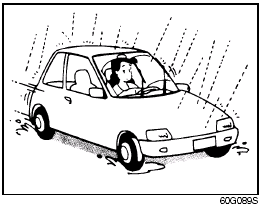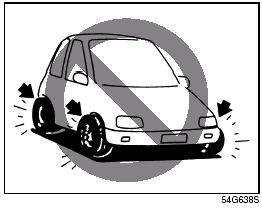Driving on Slippery Roads

Driving on Slippery Roads
Under wet road conditions you should drive at a lower speed than on dry roads due to possible slippage of tires during braking. When driving on icy, snow-covered, or muddy roads, reduce your speed and avoid sudden acceleration, abrupt braking, or sharp steering movements.
intelligent All Wheel Drive (i-AWD) Models
Your i-AWD provides greater traction on slippery roads than 2-wheel drive models.
However, your i-AWD will not have as much traction in deep snow, mud or sand as multipurpose 4WD vehicles. You should not attempt to drive your i-AWD in deep snow, mud or sand. i-AWD models are not sport/utility vehicles, and are not designed for off-road use.
If Your Vehicle Gets Stuck
If your vehicle gets stuck in snow, mud or sand, follow the directions below: 1) Shift the transaxle back and forth between a forward range (or first gear for manual transaxle) and reverse. This will create a rocking motion which may give you enough momentum to free the vehicle. Press gently on the accelerator to keep wheel spinning to a minimum wheel rpm. Remove your foot from the accelerator while shifting.
Do not race the engine. Excessive wheel spin will cause the tires to dig deeper, making it more difficult to free the vehicle.
2) If your vehicle remains stuck after a few minutes of rocking, get another vehicle to pull your vehicle out.

WARNING:
Do not allow anyone to stand near the
vehicle when you are rocking it, and
do not spin the wheels faster than an
indicated 40 km/h (25 mph) on the
speedometer. Personal injury and/or
vehicle damage may result from spinning
the wheels too fast.
CAUTION:
Do not continue rocking the vehicle
for more than a few minutes. Prolonged
rocking can cause engine
overheating, transaxle or transfer
case damage or tire damage.
Tire Chains
Tire chains should only be used if they are needed to increase traction or are required by law. Make sure that the chains you use are small-link chains or cable-type chains and are the correct size for your vehicle’s tires. Also make sure that there is enough clearance between the fenders and the chains as installed on the tires.
Install the chains on the front tires tightly, according to the chain manufacturer’s instructions. Retighten the chains after driving about 1.0 km (1/2 mile) if necessary.
With the chains installed, drive slowly.
CAUTION:
If you hear the chains hitting against
the vehicle body while driving, stop
and tighten them.
If your vehicle is equipped with full wheel caps, remove the wheel caps before installing the chains or the wheel caps can be damaged by the chain bands.
Do not drive through deep or rushing water
Driving in deep or rushing water can be hazardous. You could lose control of the vehicle and the occupants could drown.
Also, your vehicle could be seriously damaged.
To avoid these risks, observe the following instructions and precautions.
• Do not drive through deep or rushing water. Deep or rushing water, such as fast-moving streams or floodwaters, could carry your vehicle away from your intended path. The water is too deep if it covers your wheel hubs, axles or exhaust tailpipe. Know the depth of the water before you attempt to drive through it.
• If water blocks the tailpipe, the engine may not start or run. If the water is deep enough to get drawn into the engine intake system, the engine will be badly damaged.
• Submerged brakes will have poor braking performance. Drive slowly and carefully.
Driving slowly will also help avoid water splashing onto the ignition system, which could cause the engine to stall.
• Even when driving through shallow or still waters, drive carefully since the water may be hiding ground hazards such as holes, ditches or bumps.


WARNING:
In addition to following the driving
tips in this section, it is important to
observe the following precautions.
• Make sure your tires are in good condition and always maintain the specified tire pressure. Refer to “Tires” in the “INSPECTION AND MAINTENANCE” section for details.
• Do not use tires other than those specified by SUZUKI. Never use different sizes or types of tires on the front and rear wheels. For information regarding the specified tires, refer to the Tire Information Label located on the driver’s side door pillar.
• Never use oversized tires or special shocks and springs to raise (jack up) your vehicle. This will change its handling characteristics. Oversized tires may also rub against the fender over bumps, causing vehicle damage or tire failure.
• After driving through water, test the brakes while driving at a slow speed to see if they have maintained their normal effectiveness. If the brakes are less effective than normal, dry them by repeatedly applying the brakes while driving slowly until the brakes have regained their normal effectiveness.
See also:
Steering Wheel
Steering Wheel
Check the play of the steering wheel by
gently turning it from left to right and measuring
the distance that it moves before
you feel slight resistance. The play should
be betw ...
Engine Coolant
Selection of Coolant
To maintain optimum performance and
durability of your engine, use SUZUKI
Genuine Coolant or equivalent.
This type of coolant is best for your cooling
system as it:
• ...
Using the 2WD/i-AWD (intelligent All Wheel Drive) Switch (if equipped)
Using the 2WD/i-AWD (intelligent All Wheel Drive) Switch (if equipped)
This i-AWD system enables you to select
the driving mode according to the driving
conditions by operating the 2WD/i-AWD
swi ...
